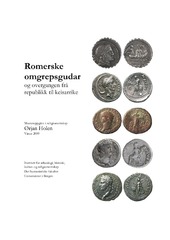Romerske omgrepsgudar og overgangen frå republikk til keisarrike
Master thesis
Permanent lenke
https://hdl.handle.net/1956/3392Utgivelsesdato
2009-05-14Metadata
Vis full innførselSammendrag
This thesis is an effort to follow the development of a certain group of gods throughout the Roman Republic, its end, and the first century of the Roman Empire. It looks at how these gods were used on the political stage, to what ends, and finally how this development changed the nature of these gods as understood by the Roman society. The group of Roman gods in question are the ones previous research has variously referred to by names such as Sondergötter, Abstract Deities, Virtues and Divine Qualities. Common examples of these include Victoria, the Roman goddess of victory, Concordia, goddess of concord, Spes, goddess of hope, and Fortuna, goddess of fortune. For the purposes of this thesis these gods are named omgrepsgudar – which roughly translates to “Concept Gods” – and are defined as those gods whose gifts to their worshippers are considered identical with the gods themselves. Opening with a presentation of previous academic work on the subject of the Concept Gods and earlier attempts to define the group, this thesis then makes its own attempt at defining this group of divinities. Then follows a look primarily at the few places in the source material where the Concept Gods are referred to as a group. This includes an in depth discussion of the only one of these sources not written from a critical anti-polytheistic viewpoint, Marcus Tullius Cicero’s De Natura Deorum from the year 45 BC. The goal of this discussion is to try to learn something of the core nature of these Concept Gods: Why they were a part of Roman religion, how they were thought of in comparison to other types of gods, and how they correspond with and relate to the other aspects of Roman religion and culture. With this broader understanding of the Concept Gods in place, the following discussion forms the main portion of the thesis. This discussion chronicles the rough development of the Concept Gods’ role in the political life of Rome from the early Republic and up until the early Empire. This is accomplished first by looking at their presence in the political life of the Republic, and afterwards by highlighting changes in the Concept Gods’ political roles towards the Republic’s end. These changes go hand in hand with the concurrent shifts in the roles of the political heads of Rome, and are deeply affected – or even effected - by them. These transitions are subsequently traced into Julius Caesar’s dictatorship, where many of the Concept Gods are related either implicitly or directly to Caesar’s person and character. The development of the Concept Gods is followed through yet another transformation as the emperor Augustus and his successors adapt them to their restructured Roman society with a single man on top. A final overview then endeavours to tie it all together with a look at how the changes the Concept Gods went through affected their essential nature and role in the state, and how this mirrored the political evolution of Rome and its leaders. Oppgåva undersøker rolla ei rekkje gudar spelte i romersk politikk ved overgangen frå republikk til keisardøme. Desse gudane skil seg ut frå andre romerske gudar ved å vere personifiseringar av såkalla "abstrakte omgrep", som semje (Concordia), siger (Victoria), håp (Spes), velferd (Salus) og nåde (Clementia). I oppgåva vert dei definert som gudar som er identiske med den gunsten dei gir sine tilbedarar og kalla "omgrepsgudar". Oppgåva undersøkjer fyrst kva som vart skreve om gudane som gruppe av romarane sjølve, og så korleis og kvifor desse gudane vart nytta i det politiske livet. Denne politiske bruken endra seg over tid, og oppgåva ser på korleis den endra seg, og kva desse endringane førte med seg for omgrepsgudane sjølve.
Utgiver
The University of BergenOpphavsrett
Copyright the author. All rights reservedThe author
